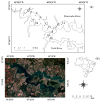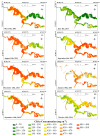Estimation of Chlorophyll-a Concentration and the Trophic State of the Barra Bonita Hydroelectric Reservoir Using OLI/Landsat-8 Images
- PMID: 26322489
- PMCID: PMC4586618
- DOI: 10.3390/ijerph120910391
Estimation of Chlorophyll-a Concentration and the Trophic State of the Barra Bonita Hydroelectric Reservoir Using OLI/Landsat-8 Images
Abstract
Reservoirs are artificial environments built by humans, and the impacts of these environments are not completely known. Retention time and high nutrient availability in the water increases the eutrophic level. Eutrophication is directly correlated to primary productivity by phytoplankton. These organisms have an important role in the environment. However, high concentrations of determined species can lead to public health problems. Species of cyanobacteria produce toxins that in determined concentrations can cause serious diseases in the liver and nervous system, which could lead to death. Phytoplankton has photoactive pigments that can be used to identify these toxins. Thus, remote sensing data is a viable alternative for mapping these pigments, and consequently, the trophic. Chlorophyll-a (Chl-a) is present in all phytoplankton species. Therefore, the aim of this work was to evaluate the performance of images of the sensor Operational Land Imager (OLI) onboard the Landsat-8 satellite in determining Chl-a concentrations and estimating the trophic level in a tropical reservoir. Empirical models were fitted using data from two field surveys conducted in May and October 2014 (Austral Autumn and Austral Spring, respectively). Models were applied in a temporal series of OLI images from May 2013 to October 2014. The estimated Chl-a concentration was used to classify the trophic level from a trophic state index that adopted the concentration of this pigment-like parameter. The models of Chl-a concentration showed reasonable results, but their performance was likely impaired by the atmospheric correction. Consequently, the trophic level classification also did not obtain better results.
Keywords: bio-optical models; case-2 waters; chlorophyll-a; multispectral image; remote sensing.
Figures










Similar articles
-
Multi-sensor satellite and in situ monitoring of phytoplankton development in a eutrophic-mesotrophic lake.Sci Total Environ. 2018 Jan 15;612:1200-1214. doi: 10.1016/j.scitotenv.2017.08.219. Epub 2017 Sep 8. Sci Total Environ. 2018. PMID: 28892864
-
Remote sensing of the chlorophyll-a based on OLI/Landsat-8 and MSI/Sentinel-2A (Barra Bonita reservoir, Brazil).An Acad Bras Cienc. 2018 Aug;90(2 suppl 1):1987-2000. doi: 10.1590/0001-3765201720170125. Epub 2017 Aug 31. An Acad Bras Cienc. 2018. PMID: 28876398
-
Empirical and semi-analytical chlorophyll a algorithms for multi-temporal monitoring of New Zealand lakes using Landsat.Environ Monit Assess. 2015 Jun;187(6):364. doi: 10.1007/s10661-015-4585-4. Epub 2015 May 19. Environ Monit Assess. 2015. PMID: 25986777
-
Challenges for mapping cyanotoxin patterns from remote sensing of cyanobacteria.Harmful Algae. 2016 Apr;54:160-173. doi: 10.1016/j.hal.2016.01.005. Harmful Algae. 2016. PMID: 28073474 Review.
-
Subsurface chlorophyll maximum layers: enduring enigma or mystery solved?Ann Rev Mar Sci. 2015;7:207-39. doi: 10.1146/annurev-marine-010213-135111. Epub 2014 Sep 17. Ann Rev Mar Sci. 2015. PMID: 25251268 Review.
Cited by
-
Validating chlorophyll-a concentrations in the Lagos Lagoon using remote sensing extraction and laboratory fluorometric methods.MethodsX. 2018 Sep 29;5:1204-1212. doi: 10.1016/j.mex.2018.09.014. eCollection 2018. MethodsX. 2018. PMID: 30622920 Free PMC article.
-
Chlorophyll-a unveiled: unlocking reservoir insights through remote sensing in a subtropical reservoir.Environ Monit Assess. 2024 Mar 27;196(4):401. doi: 10.1007/s10661-024-12554-w. Environ Monit Assess. 2024. PMID: 38538854 Free PMC article.
-
Assessment of Chlorophyll-a Algorithms Considering Different Trophic Statuses and Optimal Bands.Sensors (Basel). 2017 Jul 31;17(8):1746. doi: 10.3390/s17081746. Sensors (Basel). 2017. PMID: 28758984 Free PMC article.
-
Retrieving Inland Reservoir Water Quality Parameters Using Landsat 8-9 OLI and Sentinel-2 MSI Sensors with Empirical Multivariate Regression.Int J Environ Res Public Health. 2022 Jun 23;19(13):7725. doi: 10.3390/ijerph19137725. Int J Environ Res Public Health. 2022. PMID: 35805386 Free PMC article.
-
UAV and satellite remote sensing for inland water quality assessments: a literature review.Environ Monit Assess. 2024 Feb 17;196(3):277. doi: 10.1007/s10661-024-12342-6. Environ Monit Assess. 2024. PMID: 38367097 Review.
References
-
- Liu Y., Islam M.A., Gao J. Quantification of shallow waters quality parameters by means of remote sensing. Prog. Phys. Geogr. 2003;27:111–117. doi: 10.1191/0309133303pp357ra. - DOI
-
- Calijuri M.C., Santos A.C.A., Jati S. Temporal changes in the phytoplankton community structure in a tropical and eutrophic reservoir (Barra Bonita, S.P.–Brazil) J. Plankton Res. 2002;24:617–634. doi: 10.1093/plankt/24.7.617. - DOI
-
- Cai W.J., Hu X., Huang W.J., Murrel M.C., Lehrter J.C., Lohrens S.E., Chou W.C., Zhai W., Hollibaugh J.T., Wang Y., et al. Acidification of subsurface coastal waters enhanced by eutrophication. Nat. Geosci. 2011;4:766–770. doi: 10.1038/ngeo1297. - DOI
Publication types
MeSH terms
Substances
LinkOut - more resources
Full Text Sources
Other Literature Sources

